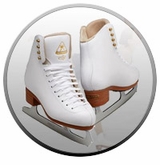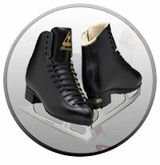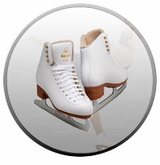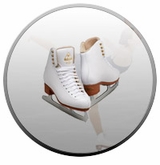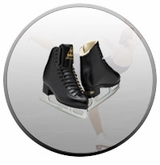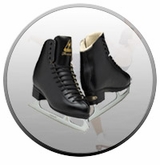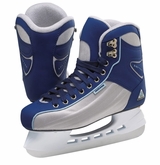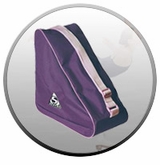Ice Skates
Ice skates come in a variety of styles and sizes to accommodate all types of ice skaters. Three of the most common types of ice skates are; figure ice skates, hockey ice skates and speed ice skates. We provide details about each of these three types of ice skates below, along with some lacing, purchasing and ice skate maintenance tips.
We also offer our visitors a great selection of quality ice skates for purchase at excellent prices. Please select from the following for Girl's Ice Skates, Boy's Ice Skates, Women's Ice Skates or Men's Ice Skates.
Figure Ice Skates
Figure ice skates are specifically designed to allow figure skaters to more easily perform figure skating jumps, figure skating spins and other figure skating moves. The figure skate boot is normally made from leather to accommodate the skaterís need for flexibility around the ankle. Figure ice skates have a sharp blade that extends beyond the back of the ice skate boot, and has a toe-pick on the front for performing jumps, and various other figure skating moves. The ice skate blades can either come mounted or sold separately from the ice skate boot. The higher quality figure ice skates normally come with the blades sold separately.
It is worth noting that ice skate blades have two edges, the inside and the outside. To understand almost anything written about ice skating, you will need to understand the lingo regarding the ice skateís blade. As you read about ice skating, you will likely encounter abbreviations like RFI or LFO. The RFI stands for: Right Forward Inside edge; Right (foot) Forward (direction of the skater) Inside (the inside edge of the blade). So in this instance, the ice skater would be expected to skate on the right skate, moving in a forward direction, and on the inside edge of the ice skateís blade. LFO stands for Left Forward Outside edge of the ice skateís blade.
Hockey Ice Skates
Hockey ice skates are made differently than figure ice skates for a variety of reasons. The main reason is because they serve a completely different purpose. Hockey ice skates are designed to withstand the physical demands of hockey players. Figure ice skates are designed to make it possible for figure skaters to perform spectacular jumps and spins, among other figure skating moves. Hockey ice skates are generally more comfortable than figure ice skates, and provide more support. Specifically, hockey ice skates differ from figure skates in several ways. 1. The blades are permanently attached to the ice skate boot. 2. Hockey ice skates do not have toe picks. 3. Hockey ice skate blades are flatter and thinner. 4. The overall weight of the skate is lighter than figure ice skates. 5. The back of the hockey ice skate blade is rounded and does not extend past the boot for safety purposes.
Speed Ice Skates
The design of speed ice skates is quit different than any other ice skate. Speed ice skates have much longer blades that extend well beyond the skating boot. Since the mid-eighties, speed skaters have been predominately wearing the new klapskate. The klapskate has a blade that is not attached at the heel to the boot, a feature that is unique to speed skating. This design prevents the tip of the blade from digging into the ice, and keeps the blade on the ice for a longer period, thereby increasing the pushing power of the speed skater. Speed ice skates are not recommended for anyone that is not actively involved with speed skating. Many ice skating rinks do not allow speed ice skates to be used for a number of safety reasons.
Purchasing Ice Skates
When you make the decision to learn to ice skate, the next decision you will likely have to make is whether to buy or rent ice skates. If you want to give ice skating a try, but are unsure if you will stick with it, we recommend renting ice skates. Once you realize you are going to stick with ice skating, purchasing your own ice skates is the only way to go. You have the choice of purchasing hockey ice skates or figure ice skates. Unless you are going to play hockey, we recommend you purchase figure ice skates. The same is true for speed ice skates. Unless you are specifically getting involved with speed skating, we donít recommend you purchase speed ice skates for recreational ice skating.
Figure ice skates provide better support and are generally easier for ice skaters to learn the basic ice skating moves on. When trying on ice skates, make sure the ice skate boot provides adequate ankle support. The ankle support should allow the skater some flexibility around the ankle, but not be too loose. If the ankle support is too loose, the skater will not be able to properly perform certain ice skating moves, and will increase the likelihood of sustaining an injury. If the ankle support is too stiff, it could also lead to injuries due to the ankleís inability to move as required.
When purchasing figure ice skates, the blades can come either separately or already attached to the skate boot. For beginners, we recommend buying ice skates with the blades already attached. For ice skaters that have a better understanding of what they need, we recommend purchasing ice skates where the blades are sold separate from the ice skate boot. Please note that all hockey ice skates have the blades already attached.
It is generally worth the money to purchase ice skates with quality ice skates blades. Otherwise, you will likely have to spend money and/or time sharpening them. Since sharpening ice skate blades requires training and the proper tools, we do not recommend you do it yourself; unless you are trained and are skilled to do so. Sharpening ice skate blades incorrectly can ruin the blades. If you donít know where to take your skates for sharpening, we recommend you call around to local ice skating rinks and ask; someone will likely be able to help you. You can use our Ice Skating Rinks locator to help you find the rinks nearest you.
If you are purchasing ice skates for children, buy them a pair that fits. Many well meaning parents purchase ice skates that are too big for their children, so they wonít out grow them as quickly. This is not a good idea when purchasing ice skates, and normally brings with it a couple of negative consequences. First, it is not safe. Children, like adults, need the ankle support and the general comfort of a good fitting pair of ice skates. Second, purchasing a pair of skates that are too large often make for a miserable skating experience; causing the child to lose interest in ice skating. If you are unsure if your child will stick with ice skating, we recommend you rent ice skates for a while. A well-fitted pair of rented skates is far better than using a pair of purchased ice skates that are too big.
When purchasing figure ice skates, keep in mind that they normally run a half size smaller than the shoe-size you normally wear. Also, when trying on figure ice skates, we recommend you do so while wearing a thin pair of socks. The skating boot should be snug, but not too tight. Lastly, when trying on the ice skates make sure that you can wiggle your toes. Ice skates should not fit so tightly that you cannot wiggle your toes.
How to Lace up Ice Skates
Lacing up your ice skates correctly is an important component of maximizing your skating experience, increasing your comfort, and the overall functionality of the ice skates. The following are some tips to help you properly lace your ice skates: 1. The laces should start out loose. 2. Pull the tongue up and straighten any potential creases in the tongue. 3. Begin tightening the laces starting on the toe end. 4. Slightingly loosen the laces around the toes (if excessively tight) and around the ankle to allow for a bend. 5. If you are wearing new ice skates, do not lace them all the way up; stop just above the ankle. 6. After a few trips to the rink, lace up another eye or two. 7. Make sure the ice skates are tied in such a way that they cannot come untied while ice skating.
Ice Skate Maintenance
You must take good care of your ice skates if you want to them to last. With proper care and maintenance, a pair of ices skates should last through many years of ice skating. Proper ice skate maintenance is an important component, not only for increasing the life of your ice skates, but for also enhancing your overall skating experience. Letís start by looking at the care and maintenance of the ice skate blade.
Some of the ice skate blade maintenance includes: wiping the ice skate blades dry when youíre finished skating, letting them warm up at room temperature (versus putting them near a heating source), and never storing them with the guards on. Also, never walk on hard surfaces while wearing your ice skates off the ice. Walking on rough surfaces can quickly ruin the ice skate blades. When blades become ruined or severely worn they should be replaced. You should purchase and wear blade guards when walking on your ice skates off the ice. The blade guards are designed to protect the blade from dulling, chipping and preventing unnecessary wear and tear. A word of caution; make sure you remove the blade guards before stepping onto the ice. Failure to do so will almost guarantee a fall, and this type of fall can lead to serious injuries to include death.
Ice skates boots need to be broken in so they are not so stiff that you cannot move your ankle. Breaking in ice skate boots can be accomplished in a number of ways. One simply way is through use. After a few trips to the skating rink, your ice skates will begin to loosen up and feel more comfortable. If you have two pairs of ice skates, you can wear the new pair for a while; then switch to the older pair to finish the skating session. This will help break them in while lessening the possibility of getting blisters that new ice skates can cause on the feet and ankles. Some people wear the ice skates around their house in order to help break them in. If you do this, be sure to consider the surfaces you will be walking on. It is also a good idea to purchase a blade guard to protect the ice skateís blade and the floorís surface.
Lastly, be sure to wipe off the ice skate boot after skating, and before storing the ice skates away. This will help prevent moisture from getting inside the ice skate boot and potentially damaging the leather.
|
Skate Equipment >
Ice Skating Equip
Ice Skating Info
.
